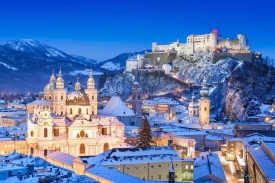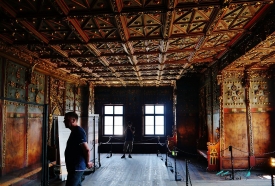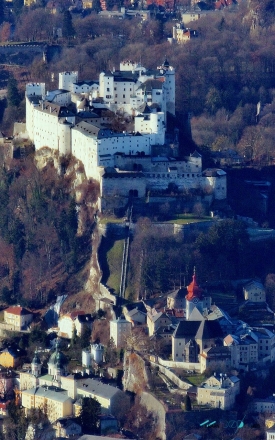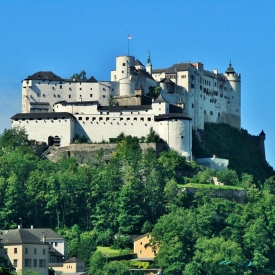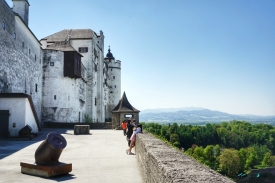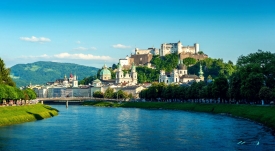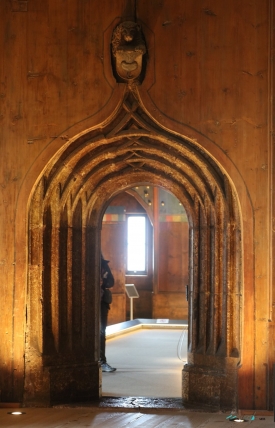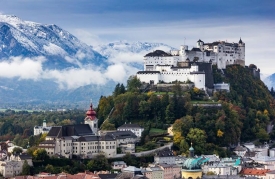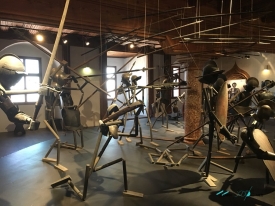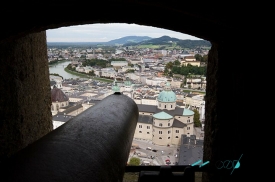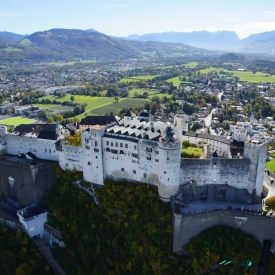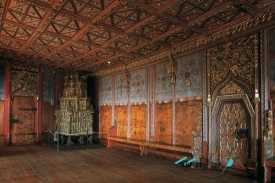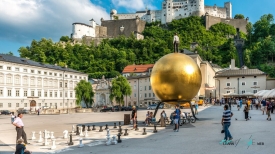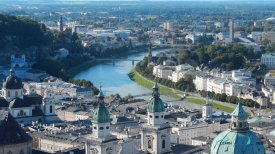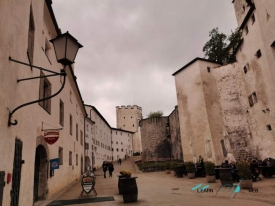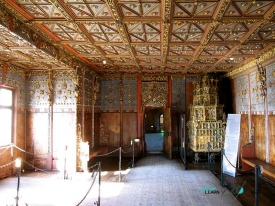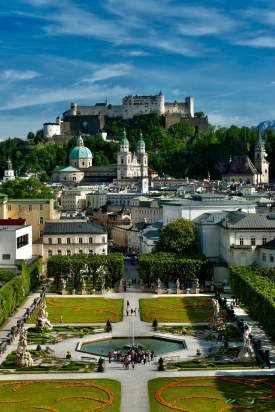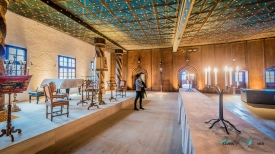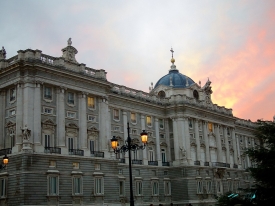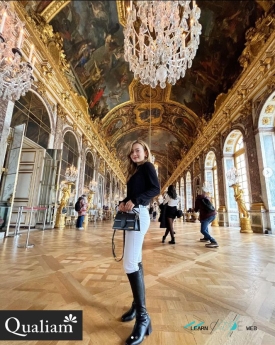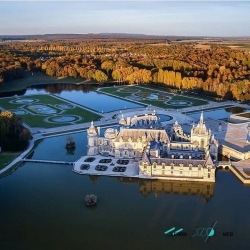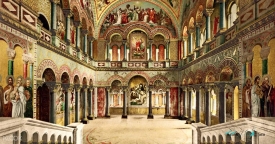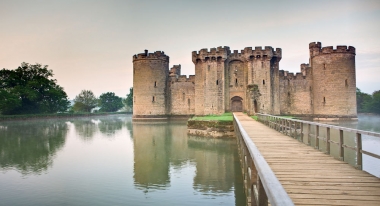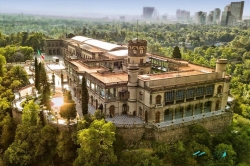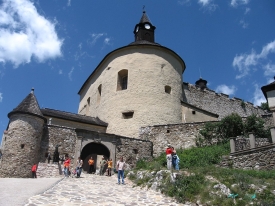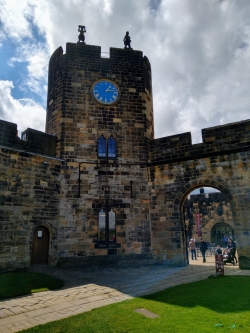ABOUT Hohensalzburg Castle
The Hohensalzburg Fortress is the landmark of the city of Salzburg. It is located on a mountain above the city, the Festungsberg, which continues to the northwest in the Mönchsberg. The branch in the east of the fortress mountain is called Nonnberg, on which the Benedictine women's monastery Nonnberg is located directly below the eastern outer facilities of the fortress - the Nonnbergbasteien. The Hohensalzburg Fortress is one of the largest castles in Europe with over 7,000 m² of built-up area (including the bastions over 14,000 m²), dating back to the 11th century. As one of the largest fully preserved castles in Central Europe, it has over a million visitors annually and is therefore the most frequently visited attraction in Austria outside of Vienna, although in the federal capital it is only surpassed by Schönbrunn Palace and Zoo and the Museum of Art History (visitor statistics 2017).
In 1077 Gebhard (1010-1088) began building a residential tower - which today still represents the core of the high floor - a small church and a small residential building with the associated wall ring. However, since Gebhard had to go into exile in the course of the investiture controversy, this building was only completed under the anti-archbishop Berthold von Moosburg, who was appointed by the emperor, and under Archbishop Konrad von Abenberg (1106–1147).
From the 12th century to the 14th century, the construction of the outer fortification ring largely determined the current extent of the castle.
In 1462, under Burkhard II von Weißpriach (1461–1466), the curtain wall was reinforced by four towers (bell tower, trumpeter tower, Krautturm, and blacksmith or detention tower), the eastern staircase over the Nonnberg protected by a meter thick wall and the south side of the castle through a bastion attached.
Under Weisspriach's successor, Bernhard von Rohr (1466–1481), the old curtain wall and the so-called serpentine corridor were raised in 1479 and served as a defense to the east towards the Nonntal and Nonnberg monastery.
Johann III. Beckenschlager (1481–1489) had the "Hohen Stock" expanded into a four-story residential building. In addition, there was the first armory and the bulk box. Here you can still find the coat of arms of Beckenschlager - the oldest coat of arms stone still existing on the Hohensalzburg Fortress.
Leonhard von Keutschach (1495–1519) continued to expand the fortress between 1495 and 1519 and, in times of increasing dangers of war, set a visible sign of his power. He had the high floor on the second and third floors expanded and expanded to include the multi-storey building that was built on the site of the previous chapel. In the course of his reign the fortress became an elegant late-Gothic seat of government, as the sumptuous prince's rooms still show today.
To improve the water supply in the event of a siege, the archbishop had a new large cistern built and some of the existing towers raised. The tearing train, today the world's oldest preserved funicular railway, the Kuchlturm and the bakery as well as several gates (Rosspforte, Schleuderpforte) and the building at the Höllenpforte were built under Leonhard von Keutschach (or one of his predecessors). The most striking work is the barrel-operated organ in the Krautturm, the Salzburg bull - similar to an oversized music box. Today it is the oldest operating organ horn factory in the world.
The funds for the brisk construction activity came mainly from salt mining on the Dürrnberg near Hallein, but also from mining in the Tauern. In 1555, in the heyday of gold mining, annual production was just under 831 kg. The experienced miners, who were often brought in from northern Germany, formed a strong nucleus of resistance against archbishopric power in the peasant wars that followed.
Under Matthäus Lang von Wellenburg (1519–1540) these peasant revolts reached their climax. From July 5 to August 31, 1525, farmers and miners besieged the Prince Archbishop in his fortress. This dispute is the greatest challenge for the Hohensalzburg Fortress in its 900-year history. The fortress, however, remained impregnable.
For Wolf Dietrich von Raitenau (1587–1612) the castle was his fate. From his successor Markus Sittikus von Hohenems (1612-1619) he was imprisoned here until the end of his life.
Paris von Lodron (1619–1653) had the city of Salzburg fortified on both sides of the Salzach with new, extensive fortifications during the Thirty Years' War; Hohensalzburg Castle in the south of the city was then expanded into a modern fortress. During his reign the mighty Hasengrabenbasteien including the armory and the expanded Nonnbergbasteien were built. Likewise, he left to protect against the stronger.
Thanks to its good state of preservation and its location, Hohensalzburg is a crowd puller. The outer fortress can be visited without a guide; A guided tour with audio guides is available for an internal part of the tour (salt magazine, torture chamber, high bar, battlements, Salzburg bull); the interiors on the high floor (princely rooms, museums) are visited single-handedly. In the summer months there has been a “Special Guided Tour” in German and English since July 2009, which has to be paid for separately and where the castle staff in disguises takes visitors on a walk through the 16th century. Otherwise closed rooms such as the Pfisterei (old bakery), the wine cellar, the Kuenburg bastion or the Viereckige Wehr can only be visited during such special tours.
For residents of the federal state of Salzburg, admission to the outdoor area is free.
In addition to the tours, concerts are held regularly, and the church is also used, for example for church weddings or on some selected public holidays. The Salzburg Marionette Museum with historical holdings of the Salzburg Marionette Theater is also located on the fortress, as well as the Museum of the K.u.k. Archduke Rainer Regiment No. 59 Infantry Regiment. There are also courses at the International Summer Academy for Fine Arts Salzburg.
In 1077 Gebhard (1010-1088) began building a residential tower - which today still represents the core of the high floor - a small church and a small residential building with the associated wall ring. However, since Gebhard had to go into exile in the course of the investiture controversy, this building was only completed under the anti-archbishop Berthold von Moosburg, who was appointed by the emperor, and under Archbishop Konrad von Abenberg (1106–1147).
From the 12th century to the 14th century, the construction of the outer fortification ring largely determined the current extent of the castle.
In 1462, under Burkhard II von Weißpriach (1461–1466), the curtain wall was reinforced by four towers (bell tower, trumpeter tower, Krautturm, and blacksmith or detention tower), the eastern staircase over the Nonnberg protected by a meter thick wall and the south side of the castle through a bastion attached.
Under Weisspriach's successor, Bernhard von Rohr (1466–1481), the old curtain wall and the so-called serpentine corridor were raised in 1479 and served as a defense to the east towards the Nonntal and Nonnberg monastery.
Johann III. Beckenschlager (1481–1489) had the "Hohen Stock" expanded into a four-story residential building. In addition, there was the first armory and the bulk box. Here you can still find the coat of arms of Beckenschlager - the oldest coat of arms stone still existing on the Hohensalzburg Fortress.
Leonhard von Keutschach (1495–1519) continued to expand the fortress between 1495 and 1519 and, in times of increasing dangers of war, set a visible sign of his power. He had the high floor on the second and third floors expanded and expanded to include the multi-storey building that was built on the site of the previous chapel. In the course of his reign the fortress became an elegant late-Gothic seat of government, as the sumptuous prince's rooms still show today.
To improve the water supply in the event of a siege, the archbishop had a new large cistern built and some of the existing towers raised. The tearing train, today the world's oldest preserved funicular railway, the Kuchlturm and the bakery as well as several gates (Rosspforte, Schleuderpforte) and the building at the Höllenpforte were built under Leonhard von Keutschach (or one of his predecessors). The most striking work is the barrel-operated organ in the Krautturm, the Salzburg bull - similar to an oversized music box. Today it is the oldest operating organ horn factory in the world.
The funds for the brisk construction activity came mainly from salt mining on the Dürrnberg near Hallein, but also from mining in the Tauern. In 1555, in the heyday of gold mining, annual production was just under 831 kg. The experienced miners, who were often brought in from northern Germany, formed a strong nucleus of resistance against archbishopric power in the peasant wars that followed.
Under Matthäus Lang von Wellenburg (1519–1540) these peasant revolts reached their climax. From July 5 to August 31, 1525, farmers and miners besieged the Prince Archbishop in his fortress. This dispute is the greatest challenge for the Hohensalzburg Fortress in its 900-year history. The fortress, however, remained impregnable.
For Wolf Dietrich von Raitenau (1587–1612) the castle was his fate. From his successor Markus Sittikus von Hohenems (1612-1619) he was imprisoned here until the end of his life.
Paris von Lodron (1619–1653) had the city of Salzburg fortified on both sides of the Salzach with new, extensive fortifications during the Thirty Years' War; Hohensalzburg Castle in the south of the city was then expanded into a modern fortress. During his reign the mighty Hasengrabenbasteien including the armory and the expanded Nonnbergbasteien were built. Likewise, he left to protect against the stronger.
Thanks to its good state of preservation and its location, Hohensalzburg is a crowd puller. The outer fortress can be visited without a guide; A guided tour with audio guides is available for an internal part of the tour (salt magazine, torture chamber, high bar, battlements, Salzburg bull); the interiors on the high floor (princely rooms, museums) are visited single-handedly. In the summer months there has been a “Special Guided Tour” in German and English since July 2009, which has to be paid for separately and where the castle staff in disguises takes visitors on a walk through the 16th century. Otherwise closed rooms such as the Pfisterei (old bakery), the wine cellar, the Kuenburg bastion or the Viereckige Wehr can only be visited during such special tours.
For residents of the federal state of Salzburg, admission to the outdoor area is free.
In addition to the tours, concerts are held regularly, and the church is also used, for example for church weddings or on some selected public holidays. The Salzburg Marionette Museum with historical holdings of the Salzburg Marionette Theater is also located on the fortress, as well as the Museum of the K.u.k. Archduke Rainer Regiment No. 59 Infantry Regiment. There are also courses at the International Summer Academy for Fine Arts Salzburg.
The Best Pictures of Hohensalzburg Castle
Videos of Hohensalzburg Castle

![Visiting the Castle [4K UHD]](https://i1.ytimg.com/vi/yz3XVLPXV1Q/mqdefault.jpg)









